Béatrice Altariba (1939) was the pretty star of many French comedies of the 1950s, often opposite her partner Darry Cowl. Till 1969 she appeared in more than 30 productions, including several Italian films.
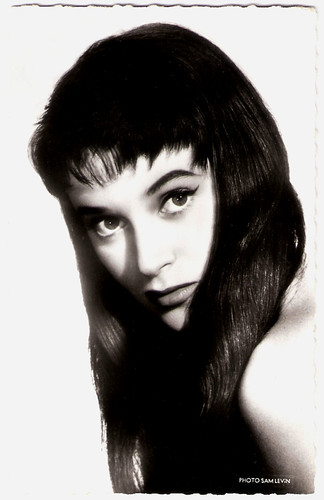
French postcard by Editions du Globe, Paris. Photo Sam Lévin.
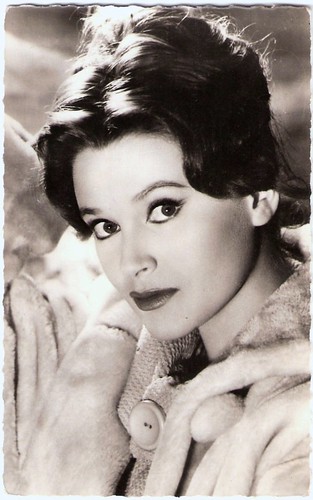
French postcard by Editions du Globe (E.D.U.G.), Paris, no. 733. Photo: Sam Lévin.
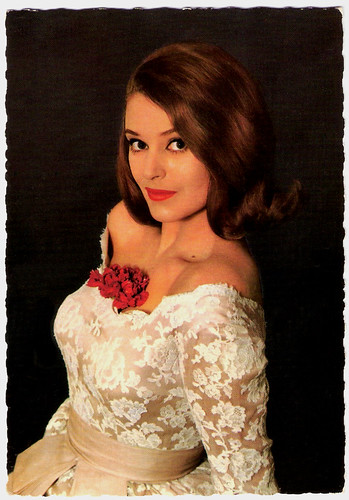
French postcard by Editions du Globe (E.D.U.G.), Paris, no. 204. Photo: Studio Pietri.
Béatrice Altariba was born Béatrice Florence Andrée Altarriba in Paris, France in 1939. She is the granddaughter of painter Émile Bernard and the small-niece of symbolist poet Paul Fort.
She started her career in revues and musical theatre, then she made her debut in the cinema at 17 in the French-Italian drama Club de femmes/Women's Club (Ralph Habib, 1956) starring Nicole Courcel, Dany Carrel and Ivan Desny.
Her early film appearances included supporting parts in films like Pardonnez nos offenses/Forgive our insults (Robert Hossein, 1956) starring Marina Vlady, Lorsque l'enfant paraît/When the Child Appears (Michel Boisrond, 1956) with Gaby Morlay, and L'homme et l'enfant/Man and Child (Raoul André, 1956) featuring Eddie Constantine.
Success came when her fiancé at the time, Darry Cowl, made her Popeline, the pretty heroine of the burlesque comedy Le Triporteur/The Tricyclist (Jacques Pinoteau, 1957) and its sequel Robinson et le triporteur/Monsieur Robinson Crusoe (Jacques Pinoteau, 1959).
Meanwhile, they were also partners in other comedies such as L'Ami de la famille/A Friend of the Family (Jacques Pinoteau, 1957), Sois belle et tais-toi/Be Beautiful But Shut Up (Marc Allégret, 1958) starring Mylène Demongeot, and Le Petit Prof/The Little Professor (Carlo Rim, 1959).
Remarkable is also her role as Cosette in Les Misérables (Jean-Paul Le Chanois, 1958), the French-East German-Italian film adaptation of the Victor Hugo novel. It stars Jean Gabin as Jean Valjean and Bernard Blier as Javert. This memorable version was filmed in East Germany and is according to Wikipedia overtly political. It was a massive hit in France, the second most popular of 1958.
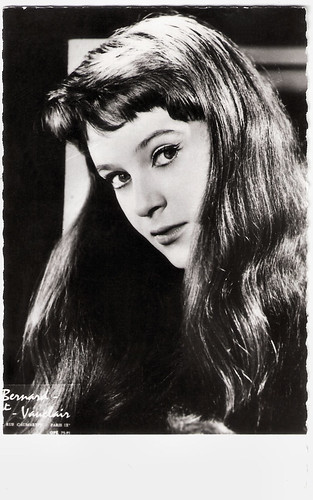
French postcard by Editions P,I,, Paris, offered by Les Carbones Korès 'Carboplane', no. 869. Photo: Bernard et Vauclair, Paris.

French autograph card. Photo: Teddy Piaz, Paris.
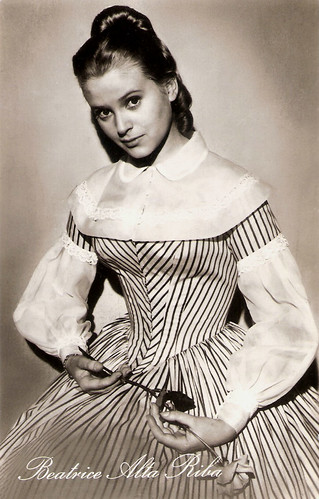
East-German postcard by VEB Progress Film-Vertrieb, no. 141/576, 1959. Photo: DEFA / Corbeau. Publicity still for Les misérables (Jean-Paul Le Chanois, 1958) with Béatrice Altariba as Cosette. The film was a co-production of DEFA (East-Germany), P.A.C. (France), Serena (Italy) and Société Nouvelle Pathé Cinéma (France).
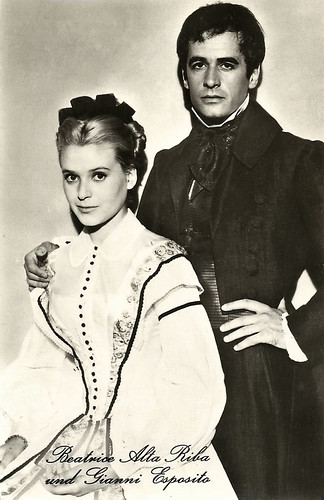
East-German postcard by VEB Progress Film-Vertrieb. Photo: DEFA. Publicity still for Les misérables (Jean-Paul Le Chanois, 1958) with Béatrice Altariba as Cosette and Giani Esposito as Marius.
Without Cowl's assistance, Béatrice Altariba continued her film career successfully into the 1960s. In the excellent horror film Les yeux sans visage/Eyes Without A Face (Georges Franju, 1960) she played one of the young and beautiful victims of a mad surgeon (Pierre Brasseur) and his assistant (Alida Valli).
The film was influential on several directors, including Spanish director Pedro Almodóvar who stated his La piel que habito/The Skin I Live In (2011), which features Antonio Banderas as a mad scientist who performs skin grafts and surgeries on an unwilling victim, was heavily influenced by Les yeux sans visage.
In Italy, Béatrice Altariba appeared opposite Anita Ekberg in the comedy A porte chiuse/Behind Closed Doors (Dino Risi, 1961) and with Brett Halsey in the historical adventure film Le sette spade del vendicatore/The Seventh Sword (Riccardo Freda, 1962). It is a remake of Freda's debut film Don Cesare di Bazan (1942). She was also Jean-Paul Belmondo’s mistress in the crime drama Un nommé La Rocca/A Man Named Rocca (Jean Becker, 1961) based on a novel by José Giovanni.
In the American B-film The Young Racers (Roger Corman, 1963) starring Mark Damon, she played a small role. The film was shot on location in Europe to take advantage of the real life grand prix. Again in Italy she played in the Totò comedy Totò diabolicus (Steno, 1963), the parody I quattro moschettieri/The Four Musketeers (Carlo Ludovico Bragaglia, 1963), and in a segment of the anthology film Su e giù/Up and down (Mino Guerrini, 1965).
Her roles got smaller through the late 1960s including an uncredited part in La prisonnière/Female Prisoner (Henri-Georges Clouzot, 1968) starring Laurent Terzieff, and a bit role as a saloon woman in the Spaghetti Western Cimitero senza croci/Cemetery Without Crosses (Robert Hossein, 1969), starring Michèle Mercier and Robert Hossein.
Her last television appearance was in the first episode of the French children's TV series Les chevaliers du ciel/The Aeronauts (1967), based on a comic book series by Jean-Michel Charlier and Albert Uderzo titled Tanguy et Laverdure, about two pilots, and their adventures in the French Air Force.
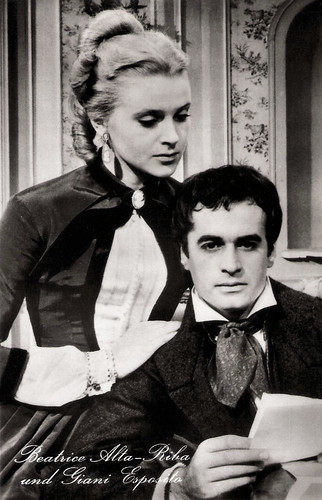
East-German postcard by VEB Progress Film-Vertrieb, no. 951, 1958. Photo: DEFA. Publicity still for Les misérables (Jean-Paul Le Chanois, 1958) with Béatrice Altariba as Cosette and Giani Esposito as Marius.
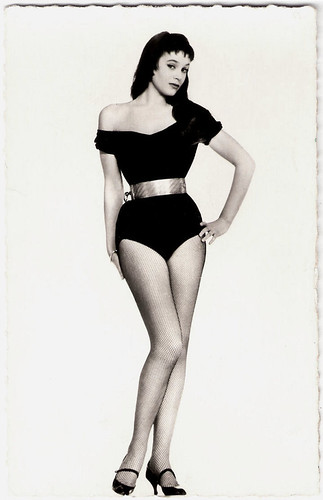
French postcard by Editions du Globe (E.D.U.G.), Paris, no. 679. Photo: Sam Lévin.
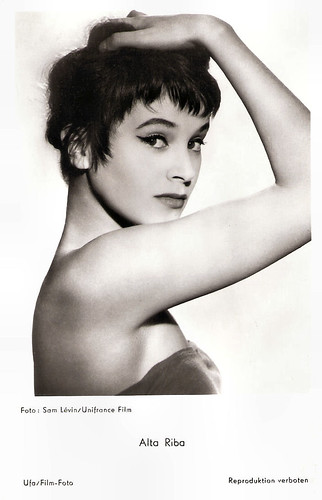
German postcard by UFA, Berlin-Tempelhof, no. FK 3400. Photo: Sam Lévin / Unifrance Film.
Sources: Jean-Pascal Consrtantin (Les Gens du Cinéma), Wikipedia (French and English) and IMDb.

French postcard by Editions du Globe, Paris. Photo Sam Lévin.

French postcard by Editions du Globe (E.D.U.G.), Paris, no. 733. Photo: Sam Lévin.

French postcard by Editions du Globe (E.D.U.G.), Paris, no. 204. Photo: Studio Pietri.
Popeline
Béatrice Altariba was born Béatrice Florence Andrée Altarriba in Paris, France in 1939. She is the granddaughter of painter Émile Bernard and the small-niece of symbolist poet Paul Fort.
She started her career in revues and musical theatre, then she made her debut in the cinema at 17 in the French-Italian drama Club de femmes/Women's Club (Ralph Habib, 1956) starring Nicole Courcel, Dany Carrel and Ivan Desny.
Her early film appearances included supporting parts in films like Pardonnez nos offenses/Forgive our insults (Robert Hossein, 1956) starring Marina Vlady, Lorsque l'enfant paraît/When the Child Appears (Michel Boisrond, 1956) with Gaby Morlay, and L'homme et l'enfant/Man and Child (Raoul André, 1956) featuring Eddie Constantine.
Success came when her fiancé at the time, Darry Cowl, made her Popeline, the pretty heroine of the burlesque comedy Le Triporteur/The Tricyclist (Jacques Pinoteau, 1957) and its sequel Robinson et le triporteur/Monsieur Robinson Crusoe (Jacques Pinoteau, 1959).
Meanwhile, they were also partners in other comedies such as L'Ami de la famille/A Friend of the Family (Jacques Pinoteau, 1957), Sois belle et tais-toi/Be Beautiful But Shut Up (Marc Allégret, 1958) starring Mylène Demongeot, and Le Petit Prof/The Little Professor (Carlo Rim, 1959).
Remarkable is also her role as Cosette in Les Misérables (Jean-Paul Le Chanois, 1958), the French-East German-Italian film adaptation of the Victor Hugo novel. It stars Jean Gabin as Jean Valjean and Bernard Blier as Javert. This memorable version was filmed in East Germany and is according to Wikipedia overtly political. It was a massive hit in France, the second most popular of 1958.

French postcard by Editions P,I,, Paris, offered by Les Carbones Korès 'Carboplane', no. 869. Photo: Bernard et Vauclair, Paris.

French autograph card. Photo: Teddy Piaz, Paris.

East-German postcard by VEB Progress Film-Vertrieb, no. 141/576, 1959. Photo: DEFA / Corbeau. Publicity still for Les misérables (Jean-Paul Le Chanois, 1958) with Béatrice Altariba as Cosette. The film was a co-production of DEFA (East-Germany), P.A.C. (France), Serena (Italy) and Société Nouvelle Pathé Cinéma (France).

East-German postcard by VEB Progress Film-Vertrieb. Photo: DEFA. Publicity still for Les misérables (Jean-Paul Le Chanois, 1958) with Béatrice Altariba as Cosette and Giani Esposito as Marius.
Beautiful Victim
Without Cowl's assistance, Béatrice Altariba continued her film career successfully into the 1960s. In the excellent horror film Les yeux sans visage/Eyes Without A Face (Georges Franju, 1960) she played one of the young and beautiful victims of a mad surgeon (Pierre Brasseur) and his assistant (Alida Valli).
The film was influential on several directors, including Spanish director Pedro Almodóvar who stated his La piel que habito/The Skin I Live In (2011), which features Antonio Banderas as a mad scientist who performs skin grafts and surgeries on an unwilling victim, was heavily influenced by Les yeux sans visage.
In Italy, Béatrice Altariba appeared opposite Anita Ekberg in the comedy A porte chiuse/Behind Closed Doors (Dino Risi, 1961) and with Brett Halsey in the historical adventure film Le sette spade del vendicatore/The Seventh Sword (Riccardo Freda, 1962). It is a remake of Freda's debut film Don Cesare di Bazan (1942). She was also Jean-Paul Belmondo’s mistress in the crime drama Un nommé La Rocca/A Man Named Rocca (Jean Becker, 1961) based on a novel by José Giovanni.
In the American B-film The Young Racers (Roger Corman, 1963) starring Mark Damon, she played a small role. The film was shot on location in Europe to take advantage of the real life grand prix. Again in Italy she played in the Totò comedy Totò diabolicus (Steno, 1963), the parody I quattro moschettieri/The Four Musketeers (Carlo Ludovico Bragaglia, 1963), and in a segment of the anthology film Su e giù/Up and down (Mino Guerrini, 1965).
Her roles got smaller through the late 1960s including an uncredited part in La prisonnière/Female Prisoner (Henri-Georges Clouzot, 1968) starring Laurent Terzieff, and a bit role as a saloon woman in the Spaghetti Western Cimitero senza croci/Cemetery Without Crosses (Robert Hossein, 1969), starring Michèle Mercier and Robert Hossein.
Her last television appearance was in the first episode of the French children's TV series Les chevaliers du ciel/The Aeronauts (1967), based on a comic book series by Jean-Michel Charlier and Albert Uderzo titled Tanguy et Laverdure, about two pilots, and their adventures in the French Air Force.

East-German postcard by VEB Progress Film-Vertrieb, no. 951, 1958. Photo: DEFA. Publicity still for Les misérables (Jean-Paul Le Chanois, 1958) with Béatrice Altariba as Cosette and Giani Esposito as Marius.

French postcard by Editions du Globe (E.D.U.G.), Paris, no. 679. Photo: Sam Lévin.

German postcard by UFA, Berlin-Tempelhof, no. FK 3400. Photo: Sam Lévin / Unifrance Film.
Sources: Jean-Pascal Consrtantin (Les Gens du Cinéma), Wikipedia (French and English) and IMDb.
No comments:
Post a Comment